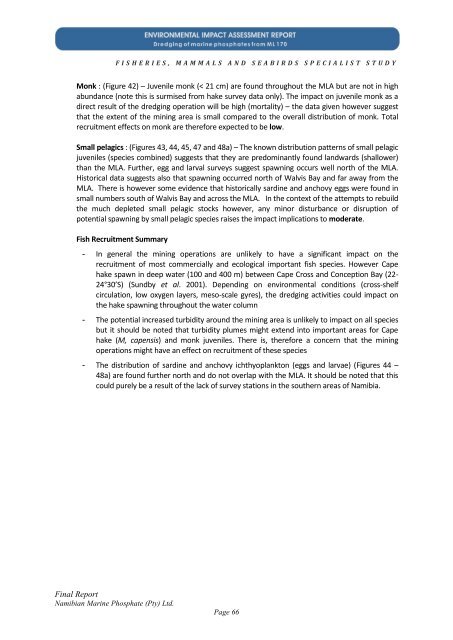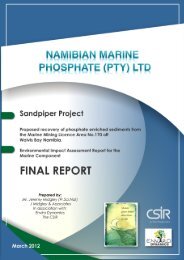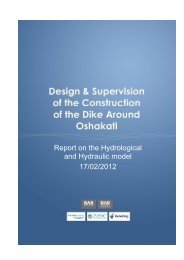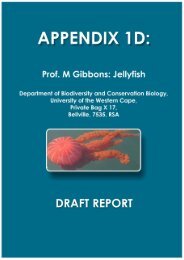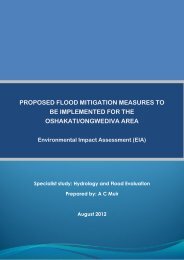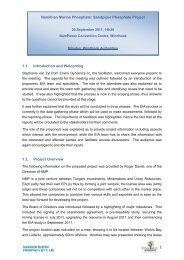Fisheries - Enviro Dynamics Namibia
Fisheries - Enviro Dynamics Namibia
Fisheries - Enviro Dynamics Namibia
You also want an ePaper? Increase the reach of your titles
YUMPU automatically turns print PDFs into web optimized ePapers that Google loves.
F I S H E R I E S , M A M M A L S A N D S E A B I R D S S P E C I A L I S T S T U D Y<br />
Monk : (Figure 42) – Juvenile monk (< 21 cm) are found throughout the MLA but are not in high<br />
abundance (note this is surmised from hake survey data only). The impact on juvenile monk as a<br />
direct result of the dredging operation will be high (mortality) – the data given however suggest<br />
that the extent of the mining area is small compared to the overall distribution of monk. Total<br />
recruitment effects on monk are therefore expected to be low.<br />
Small pelagics : (Figures 43, 44, 45, 47 and 48a) – The known distribution patterns of small pelagic<br />
juveniles (species combined) suggests that they are predominantly found landwards (shallower)<br />
than the MLA. Further, egg and larval surveys suggest spawning occurs well north of the MLA.<br />
Historical data suggests also that spawning occurred north of Walvis Bay and far away from the<br />
MLA. There is however some evidence that historically sardine and anchovy eggs were found in<br />
small numbers south of Walvis Bay and across the MLA. In the context of the attempts to rebuild<br />
the much depleted small pelagic stocks however, any minor disturbance or disruption of<br />
potential spawning by small pelagic species raises the impact implications to moderate.<br />
Fish Recruitment Summary<br />
- In general the mining operations are unlikely to have a significant impact on the<br />
recruitment of most commercially and ecological important fish species. However Cape<br />
hake spawn in deep water (100 and 400 m) between Cape Cross and Conception Bay (22-<br />
24°30’S) (Sundby et al. 2001). Depending on environmental conditions (cross-shelf<br />
circulation, low oxygen layers, meso-scale gyres), the dredging activities could impact on<br />
the hake spawning throughout the water column<br />
- The potential increased turbidity around the mining area is unlikely to impact on all species<br />
but it should be noted that turbidity plumes might extend into important areas for Cape<br />
hake (M, capensis) and monk juveniles. There is, therefore a concern that the mining<br />
operations might have an effect on recruitment of these species<br />
- The distribution of sardine and anchovy ichthyoplankton (eggs and larvae) (Figures 44 –<br />
48a) are found further north and do not overlap with the MLA. It should be noted that this<br />
could purely be a result of the lack of survey stations in the southern areas of <strong>Namibia</strong>.<br />
Final Report<br />
<strong>Namibia</strong>n Marine Phosphate (Pty) Ltd.<br />
Page 66


